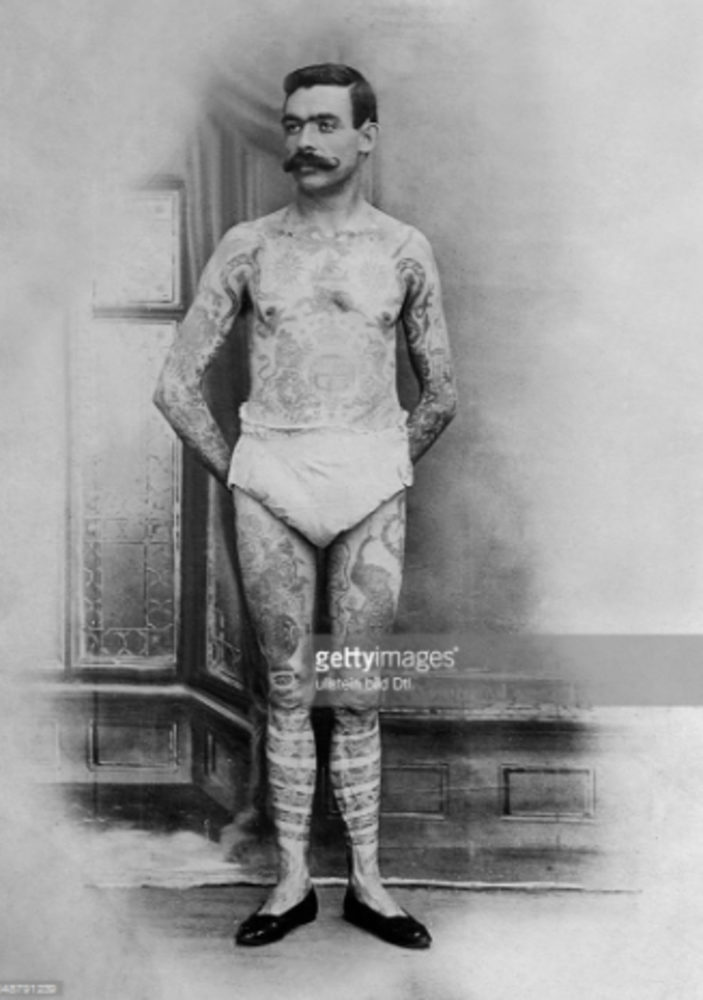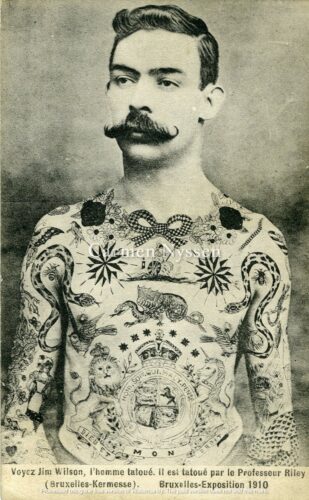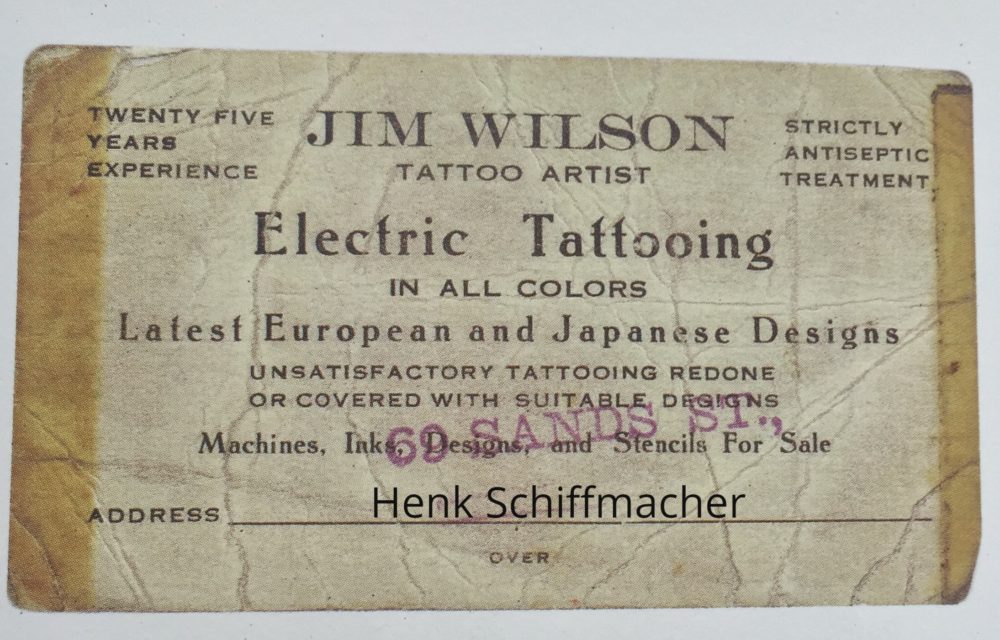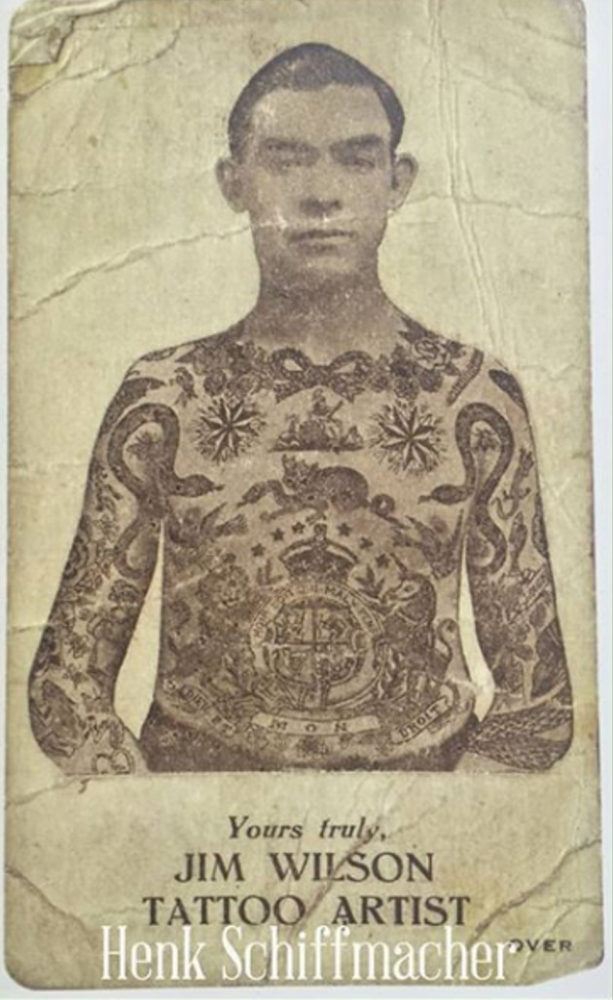
Jim Wilson
Researched & Written by Carmen Nyssen
Born: 29 Mar 1870 Crowle, Lincolnshire, England
Died: 12 Feb 1939 Corozal, Panama
Although British tattooer James “Jim” Wilson wasn’t as renowned in tattooing as his mentor, the “World’s Famous” Tom Riley, he followed in Riley’s wandering footsteps. In the earliest part of his career, he dotted cities across the U.K., wielding his needle in a range of settings—from the gala of refined amusement exhibitions to the sordidness of rough-and-ready seaports. These travels no doubt afforded him great variety in his chosen profession, but one continent’s tattoo traditions weren’t enough to hold his interest. About a decade into his career, he left his native country to broaden his horizons and set sail for new tattooing adventures, interconnecting with a diversity of tattoo characters.
Tom Riley & Jim Wilson Partnership
A 1926 Brooklyn, New York syndicate interview documents that Jim Wilson had “learned his stuff” back in England from “Old” Tom Riley. While it doesn’t state the exact date of their partnership, the two had definitely met sometime prior to November of 1902. According to a notice in British amusement newspaper, The Era, by this time, Riley had covered Wilson and his wife Annie in a colorful array of designs, and began contracting them out for exhibition during a short interim stint at London’s Royal Aquarium.
1902 Nov 15 The Era pg. 30
“Wanted, Known, Jim and Annie Wilson, Tattooed in Seven Colors by Tom Riley, the Royal Tattooist, Want Engagement for Dec 22d onwards. First class wardrobe, Posters, &c, Write or Wire, Tattooer, Royal Aquarium, Westminster, London.”
By the next year, after Riley had sufficiently instructed Wilson in the craft of tattooing, he enlisted him as an assistant in his outside-London stall at E.H. Bostock’s celebrated Glasgow, Scotland menagerie.

1903 Dec 5 Sporting Times pg. 8
“Tattooing-Tom Riley Society Tattooist, Now at 432, Strand, London, W.C.
And at the Scottish Zoo, Glasgow, represented by his assistant Mr. J. Wilson”
Tattooing Europe
Evidence of Wilson’s travels over the next few years is sparse, but available records document some of his tattoo exploits after he parted ways with Riley. A stock, novelty postcard of his decorated torso advertises his appearance as a tattooed attraction at the spectacular 1910 Brussels World’s Fair Exposition (April to November). Writing on the backside of one of these circulated postcards places him just afterward in the south seaside town of Weymouth, England, tattooing with a new partner named “Bowman” who possibly also worked with him in the Royal Navy village of East Stonehouse.

__
According to census and directory records, by 1910, Wilson, his wife Louisa, sister-in-law, and father-in-law were operating a refreshment and boarding house on bustling Union Street, No. 111, in East Stonehouse. Their business—which catered to the numerous sailors passing through town and sat near the showy New Palace Theatre—likely housed Wilson’s tattoo stand as well. And, living just around the corner at 76 East Street was his Weymouth colleague, Glasgow-born tattoo artist John Bowman (1881-1930), and his tattooed wife.
America Bound
The where and why of Wilson’s move in 1911 isn’t known, though it was possibly prompted by an invitation from a friend, who had left England for the U.S. only several years prior. In September of that year, Wilson left for New York and was soon after tattooing and operating a shooting gallery with British tattoo artist, Jack Gavett, who had already found a niche on Brooklyn’s seedy Sands Street sailor haven, near the Navy yard.
1911 Dec 14 New York Herald pg. 29
“Young man wanted assist in shooting gallery. Apply Gavett & Wilson’s Tattooing Studio, 223 Sands st., Brooklyn.”
As noted in a New York Herald advertisement, their operation was first set up at 223 Sands Street, but by April of 1912, when Wilson declared his intent to become a U.S. citizen, they had found new quarters at 79 Sands Street—Gavett’s shop until the late 1920s in New York.
With the exception of a turn-around trip to England in September of 1912 (he did not bring his wife back with him), the U.S. remained Wilson’s home for a number of years. Yet, he didn’t plant his feet in one location.

Tattoo Town Norfolk
At some point, on his first U.S. visit Wilson had trekked to Norfolk, Virginia and connected with old-time tattoo artist and electric tattoo machine guru, Captain Elmer Getchell. By 1914, after a couple more years in Brooklyn, he returned and partnered with Getchell in The Midway Saloon—at his 238 Avon (previously 85 Avon) shooting gallery-tattoo shop.
Norfolk suited Wilson enough that, in 1916, he opened his own tattoo establishment at 510 Cove, between Wells Piano Co. and Norfolk Livery & Boarding Stables. Then, at the onset of World War I, in 1917, when tattooer’s flocked to East Main Street to cash in on non-stop sailor clientele flowing from Norfolk Naval station, he set up in the Ocean House, No. 429—one block away from Getchell at No. 611 and newcomer Harry Lawson at No. 601.

Booming tattoo business, and U.S. life in general, apparently impressed Wilson. In 1917, as documented in Federal Naturalization records witnessed by Norfolk residents W.P. Davies, owner of the Midway Saloon, and W.T. Wells, his piano dealer neighbor, he decided to make the country his permanent home. A mass influx of tattooers within the next year, however, is probably what drove him away from this particular city. By 1919, he had moved back to New York and Andy Stuertz and Cap Coleman took over his No. 429 East Main Street tattoo shop.
Back on Sands Street
For a good ten years, from 1918 to 1927, Wilson made Brooklyn his home. He remarried and prospered etching the numerous sailors that alighted Sands Street—or ‘Tattoo Row’—at his No. 69 photo studio-tattoo shop-shooting gallery.

Tattoo business waned at the closing of the 1920s decade though. Along with fellow Sands Street tattooers, Jack Gavett, Lew Alberts, and British transplant Bill Donnelly, he abandoned the once reliable tattoo-stretch. This time he set his sights southward and tried his luck in a yet another foreign land—the laid-back coastal city of Panama, Central America.
1927 Jan 30 Brooklyn Daily Eagle pg. 58
“And look at Jim Wilson, a drunken artist of the tattooing world, who sold his studio on Sands Street for $50—it was worth $250—and grabbed a ship bound for Panama where he is now posing as a walking gallery for a sideshow.”

Honolulu Tattooing
Perhaps on the word of old friend, Jack Gavett, or one-time Norfolk cohort, Harry Lawson, each of whom spent time tattooing in Hawaii in the late 1920s, Wilson ventured out again. In December of 1928, he sailed from Balboa, Panama to San Diego, then several months later, out of San Francisco to work a spell in Honolulu. His tattoo shop at 146 N. Hotel was a popular location that in subsequent years accommodated Long Andy Libarry and Rosie Camanga.
Epic Tattoo Journey
By the end of his life, Wilson had been on an amazing tattoo journey, making the acquaintance of tattooers from all walks of life. The Hawaii trip, which only lasted until April of 1929, may have been the last of his wanderlust journeys, however. Once back in Panama, he seems to have tattooed there until his death in 1939.
